Managing our lineside environment
Managing Trees and Vegetation in your area
Scotland’s Railway makes up more than 17 percent of Britain’s rail network, some 3,504 miles of lineside. The management of trees and vegetation protects the operational railway line and helps keep passengers safe, trains punctual and reduces risk for lineside neighbours. Our tree and vegetation management process involves careful planning and is a coordinated effort across our business.
-
Why do we need to manage trees and vegetation?
If not managed, overgrown trees and vegetation close to the railway can become dangerous and pose safety risks to trains, our passengers, railway staff and contractors, lineside neighbours and adjacent land users and owners.
Lineside trees and vegetation can obscure signals, interrupt power supplies, reduce visibility, cause injuries, and damage or even derail trains. In autumn, train acceleration and braking can be adversely affected in locations where leaf-fall is significant in volume. Incidents caused by trees and vegetation cost Scotland’s Railway (and the taxpayer who fund us) significant sums, as well as causing disruption and sometimes severe delays to trains and passengers.
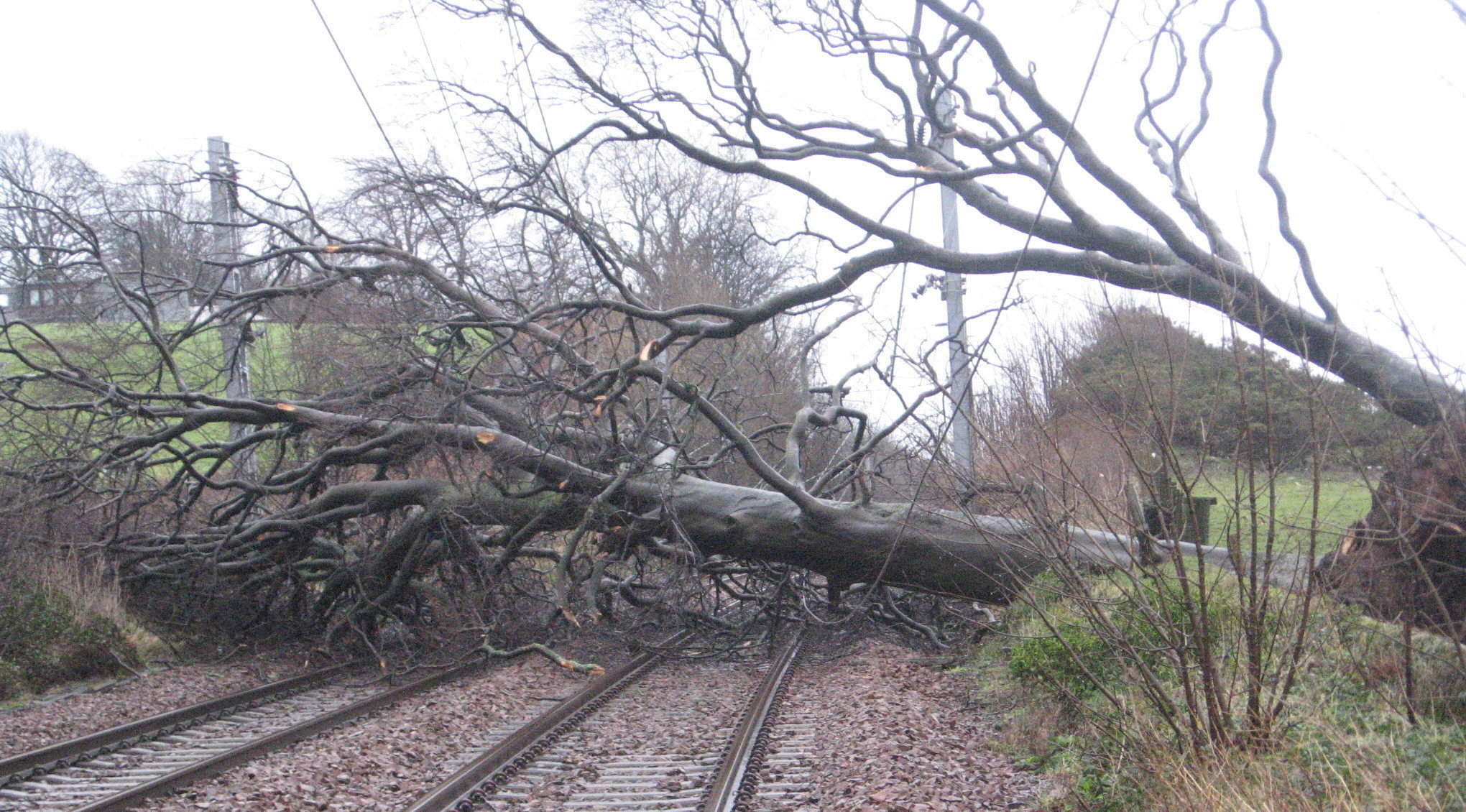
-
Where tree and vegetation management is required
We routinely clear trees and vegetation from the area immediately next to the track. Where trains run at higher speeds, in cuttings or on embankments, or where there are signals, level crossings or overhead line equipment, we may need to clear trees further back. This will also include clearing trees confirmed as in a hazardous condition
To maintain our railway, and also on land further away from the operational line, there are times when we need to clear areas of trees and vegetation to help our trackside teams examine or repair earthworks and structures or as part of larger programmes of work, such as to prepare for overhead line electrification. To reduce the problems caused by leaves falling on the railway in the autumn, we target the maintenance or removal of certain broadleaf tree species.
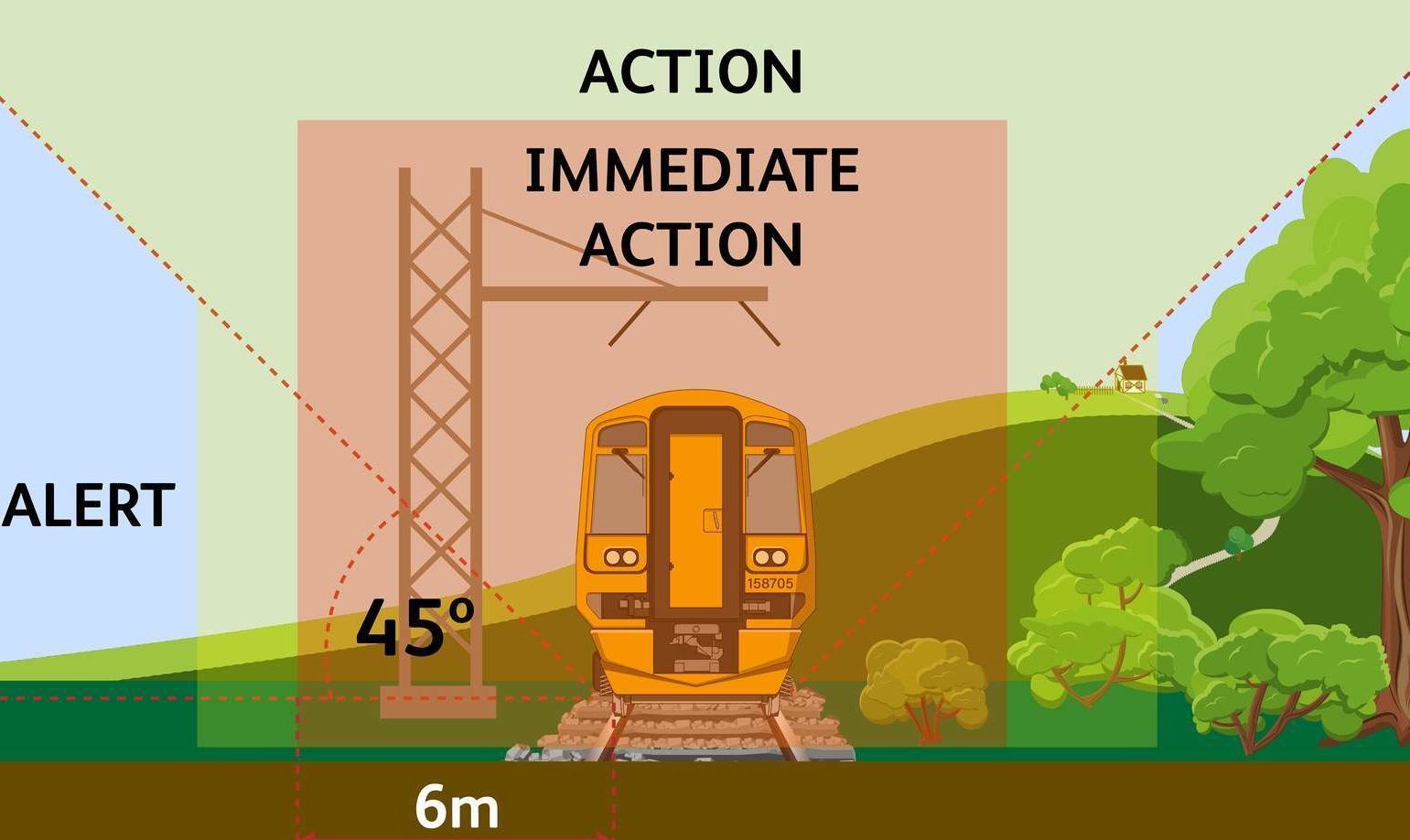
This image shows how we evaluate the threat of trees and other vegetation to the railway and is generic for level ground and where there is a wide railway verge. The ‘immediate action’ zone describes the area where vegetation is acted upon due to either coming into contact with trains or overhead line equipment, affecting the sighting of signals and level crossings, or obstructing safe walking routes for staff. Trees and vegetation in the ‘action’ zone are managed where they would present a safety risk to the railway if they fell, along with any trees that present a particularly high leaf-fall risk in autumn. The ‘alert’ zone is the area that requires ongoing maintenance and mitigation against any safety risk from larger trees, and areas where there is a particularly high density of leaf-fall. (Please note that on sites with a narrow verge or on slopes it may not be possible to safely retain trees due to geotechnical, tree failure and autumn risks).
-
Our approach to each project
First, we carry out specialist ecology inspections of the proposed area on both sides of the railway. An additional thorough desk-based check using our specialist mapping software is also conducted. This helps us decide how to safeguard nesting birds, other protected species (such as bats) and to obtain permission to work on designated sites. Our teams will then start working along the railway line where possible during the day, or at times at night, to cut back trees and vegetation to safe levels. We’ll cut back trees that pose a safety risk, the distance of these trees from the tracks will vary depending on site specific risks. If there are trees outside our boundary that could pose a safety risk to the railway line, we’ll talk to the landowner to agree a plan of action with them to keep the railway safe.
-
Protecting the environment and improving biodiversity
We take our environmental obligations extremely seriously and we manage our lineside with safety, performance and biodiversity in mind. We aim to create compatible areas on the land directly beside our railway optimised for invertebrates (such as pollinating insects) and non-woody plant species. This type of habitat once established is diverse as it also supports birds, mammals and reptiles to visit and forage. We have a team of ecologists to advise us on protected species and habitat management.
Where possible, we try to protect and maintain the environment the railway runs through. However, when we must prune or remove trees we fully comply with the law. For example, during the nesting season we monitor and protect active bird nests until the young birds have fledged.
Where there is enough room and it is safe to do so, after pruning or removing trees, we leave smaller branches as habitat for wildlife, such as hedgehogs and amphibians. Depending on tree species and availability of distance away from the tracks and other railway equipment, we may allow tree stumps to regrow. Where we cannot do this, woody stumps are treated with an eco-plug containing a measured dose of government approved herbicide to stop unwanted regrowth and prevent leaching into the environment. More information on the eco-plugs can be found here: http://www.ecoplug.com/product-information/ecoplug-faq.
Our approach is based on guidance and best practice from a range of conservation groups.
-
Could works be carried out during the day instead of at night?
Our preference would be to undertake tree and vegetation management works during the day and will only proceed at night when there is no other alternative. We try to carry out our works at the least disruptive time possible and as there is a requirement for chainsaws and tree-climbing, daylight hours are always preferable from a safety perspective.
-
Will cutting down trees affect noise levels?
In specific situations, trees can reduce noise. Belts of dense evergreen trees up to 50 feet deep and 30 feet tall, with dense shrubs at ground level can reduce some noise. However, the reality is that this very specific environment does not exist along our railway and what is in place does little to reduce noise. While we appreciate the feeling of disturbance can be heightened when a sound source becomes more visible, it is important that these works are carried out to ensure the safety of our neighbours, passengers and staff.
-
Does Network Rail need permission to fell trees?
Network Rail is a statutory undertaker mandated to operate a safe and reliable railway and does not require permission to fell trees if they are on our own land and pose a risk to the safe operation of the railway. Where we need to work out-with our land or there is a Tree Preservation Order or the location is within a Conservation Area, there can be obligations to notify or obtain permission from the Planning Authority.
-
What you can do to help us
If you are a lineside neighbour and you need to cut down trees on your own land, or are concerned about trees on your own land that could potentially affect the safety of the railway, please contact our Asset Protection department: assetprotectionscotland@networkrail.co.uk or call (Monday to Friday during normal working hours only) : 0141 555 4087. If there is an urgent need to contact us out with these hours, please call the National Help Line on 03457 11 41 41
Fencing
Safety is an absolute priority for Network Rail. We constantly strive to make Scotland’s railway as safe as possible, not only for passengers but also for those living alongside the railway.
The fencing we use to mark the boundary of our land also serves as a deterrent to prevent trespass and vandalism. Part of a structure, buildings – and occasionally natural screens of thorny shrubs – can also act as railway boundaries.
Our fencing is inspected on a regular basis, typically annually. The type of fence we provide depends on location and the use of the land adjacent to it and is informed by our inspection programme.
Why do we need to renew fencing?
Our commitment to have a safe and reliable railway for our passengers, freight customers, communities landowners and farmers living and working alongside the railway means that we need to carry out regular work on the railway’s boundary.
Renewal of fencing helps to ensure the safety of the operational railway. This keeps our passengers safe, trains punctual and reduces risk for our neighbours. Our fencing renewal process involves careful planning and is a coordinated effort across our maintenance and renewal teams.
We renew fencing to fulfil our legal obligation to keep the railway secure through appropriate boundary measures. It also allows our neighbours to use and enjoy their land safely, separated from trains and other risks found on railway land.
The type of fencing we install, and how we maintain it, varies across our network and is dependent on location and how the adjacent land is being used and the type of risk this may represent for the railway.
About our fencing
-
What you can do to help us
As mentioned, the purpose of our boundary measures is to keep both you and our passengers safe. With this in mind, it is important that you:
- Keep our fence in place and intact. If the fence is damaged in a way that affects its integrity, let us know as soon as possible. Our contact details are below
- Do not alter the fence to allow access onto the operational railway (e.g., addition of a gate)
- Do not alter the fence to reduce its effectiveness as a barrier (e.g., raising the ground level which then reduces the height of the fence from your side, or remove parts of the fence)
Failure to comply with the above creates a safety risk to you, our neighbours, and our passengers. It could result in trespass and/or vandalism on the railway which is illegal and dangerous. You could be taken to court and face a fine of up to £1,000.
You can also help us improve our fencing by facilitating access for our staff and contractors to inspect or repair fences or to replace those that are scheduled for renewal.
-
What to do if there is a problem
We are responsible for the fencing that forms the boundary to the railway. If there’s a problem with our fencing, we will either repair the fence or replace it. This doesn’t apply to other fences that may be parallel to our boundary measure.
If our fencing is showing signs of age and deterioration, let us know and we will inspect its condition. If there’s a gap and we can’t immediately carry out a permanent repair, we’ll do a temporary repair first.
If we can’t repair the fence to a safe standard, and a fence is needed to keep the railway safe, we will add it to our renewals programme and replace it with a new one of a similar size and type. Where site specific circumstances require, we may replace it with a higher specification, particularly if trespassing, vandalism, or fly-tipping are recorded.
You can report all fencing and boundary issues to 24/7 national helpline on 03457 11 41 41 and our Maintenance team will be mobilised to assist as soon as they can. -
Working with farmers
Network Rail currently manages 3,862km of livestock and strained wire fencing across Scotland.
Boundary fencing plays a crucial role in controlling livestock incursion risks and we are keen to work with farmers across Scotland to ensure fencing faults are quickly detected and dealt with.
On average we see 80 to 100 livestock incursions onto Scotland’s railway every year, causing disruption to our passengers and risk to the livestock.
We appreciate that farmers rotate livestock through multiple fields, and we want to cooperate with them by checking appropriate fencing is in place to ensure the safety of their animals. Advising Network Rail when planning to move livestock to another field will allow us to assess and check the suitability of any fencing repairs or upgrades that may be required.
Farmers know their field and boundary conditions intimately, so are often the first to spot any issues and we encourage them to flag their concerns to us as soon as possible. To report any damaged or inadequate fencing, or a livestock incursion, please call the 24-hour Network Rail national helpline on 03457 11 41 41.
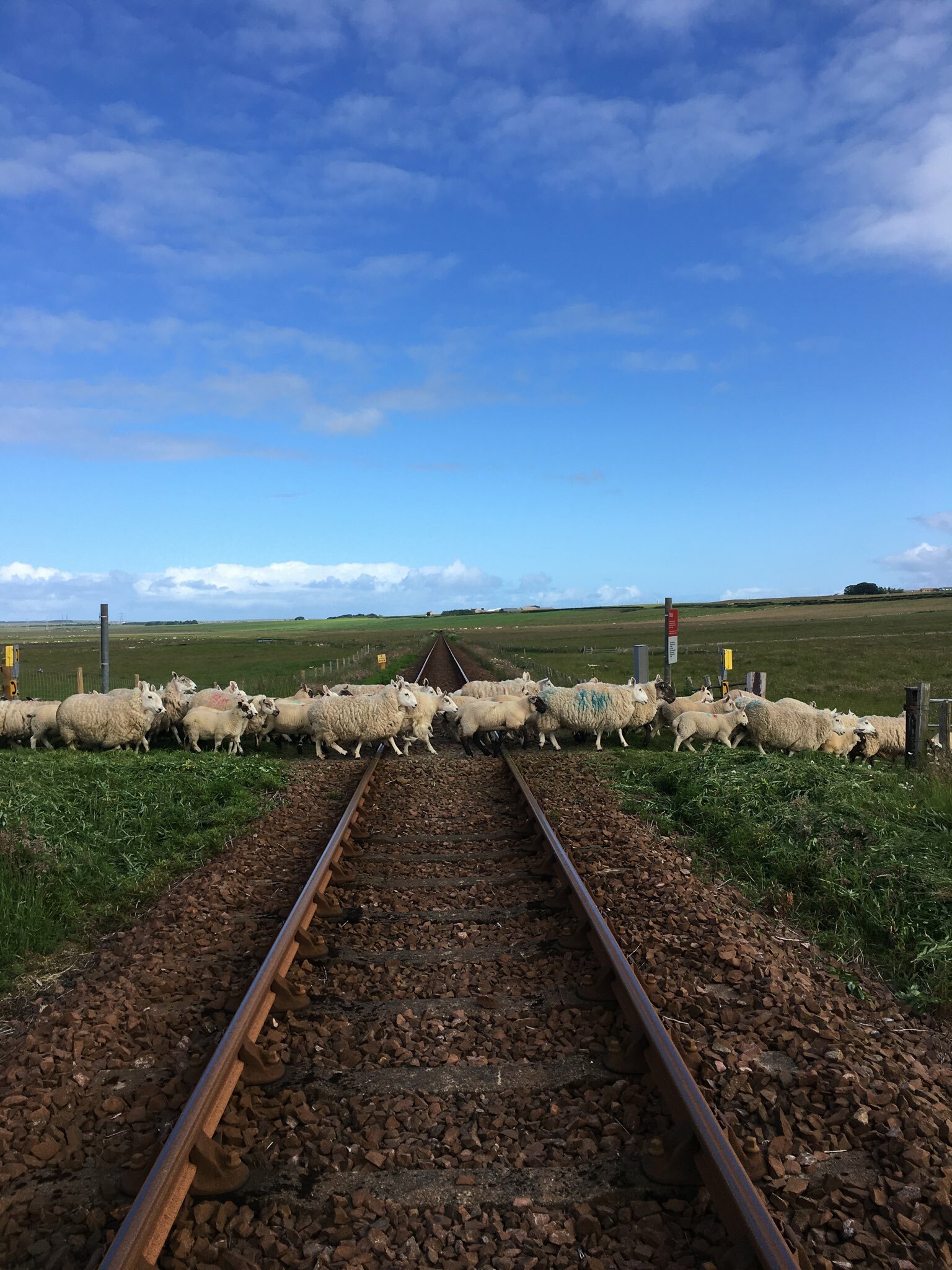
Sheep crossing the railway -
Hedgehog highway
Across Scotland’s Railway we take our environmental obligations extremely seriously. We are committed to minimising our ecological and environmental impacts and are trialling the installation of ‘hedgehog highways’ adjacent to urban areas, including back gardens, as part of our boundary fencing renewal programme. We are doing this because the population of hedgehogs in Britain is suffering serious decline.
Hedgehogs travel around one mile every night through our parks and gardens. They are a gardener’s friend that eats slugs, snails, and insects. We can make their life a little easier by removing the barriers within our control – for example, by making holes in or under our fences and walls for them to pass through.
Where appropriate and with agreement of our neighbour, we will install an opening to allow for a ‘hedgehog highway’ to be established along the boundary. The single hole will be approximately 13cm by 13cm which is sufficient for any hedgehog to pass through but will be too small for nearly all pets. Where a pet(s) resides at the property which may be of the size to pass through the hole, if you are agreeable, a pet-friendly alternative can be installed.
The below photograph is for illustrative purposes but is intended to provide an impression of the size of the opening and the sign that Network Rail will provide to clearly display the purpose of the hole.
These signs are made from recycled green plastic and will be pinned above your hedgehog hole to ensure it is not blocked by anyone accidentally.
Network Rail will pay for the signs so this will be at no cost to you. This unfortunately won’t be possible at properties that require close-boarded timber fence topper on a wall.
-
Palisade fencing
This is security fencing, typically 1.8m high, which can be galvanised or powder coated depending on where it is erected. This type of fencing is used to deter trespass and is commonly found near schools, or other urban locations where people could easily access the railway or other urban locations where people and children may be regularly in close proximity to the railway boundary.

Palisade fencing -
Expanded mesh fencing
Security fencing made of expanded metal is usually used to deter trespass, often in urban areas. Like palisade, it can be galvanised or powder coated. This fencing material works well on level terrain, but the shape of the panel means that it can be difficult to use on uneven ground.

Expanded mesh fencing -
Welded mesh panel fencing
This type of security fencing has recently been approved for use by Network Rail. It is a metal security fence that is commonly used around schools and also as a boundary fence alongside gardens of lineside neighbour.

Welded mesh panel fencing -
Welded mesh roll fencing
This is 1.8m general-purpose fencing and is commonly used to discourage trespass in urban and rural areas, such as along paths, beside sports fields and in country parks.

Welded mesh roll fencing -
Timber fencing
There are two commonly used types of timber fencing. Feather edged, where the boards overlap and close-boarded, which has a gap between boards (see picture). These types of fences are generally used adjacent to lineside neighbour gardens.
Timber fencing -
Timber fence topper
For urban locations such as gardens that have an existing wall that does not meet minimum height requirements, we may instead install a close-boarded timber fence topper to bring the overall boundary height to 1.8m.

Timber fence topper -
Stock fence
This type of fence is 1.35m high and is typically installed along field boundaries to control the risk of livestock incursions onto the railway. If required, the top wire can be changed from barb wire to a plain wire and horse netting can also be installed instead of the typical stock netting. This type of fence makes up the majority of the fencing that we install across Scotland’s railway boundaries.
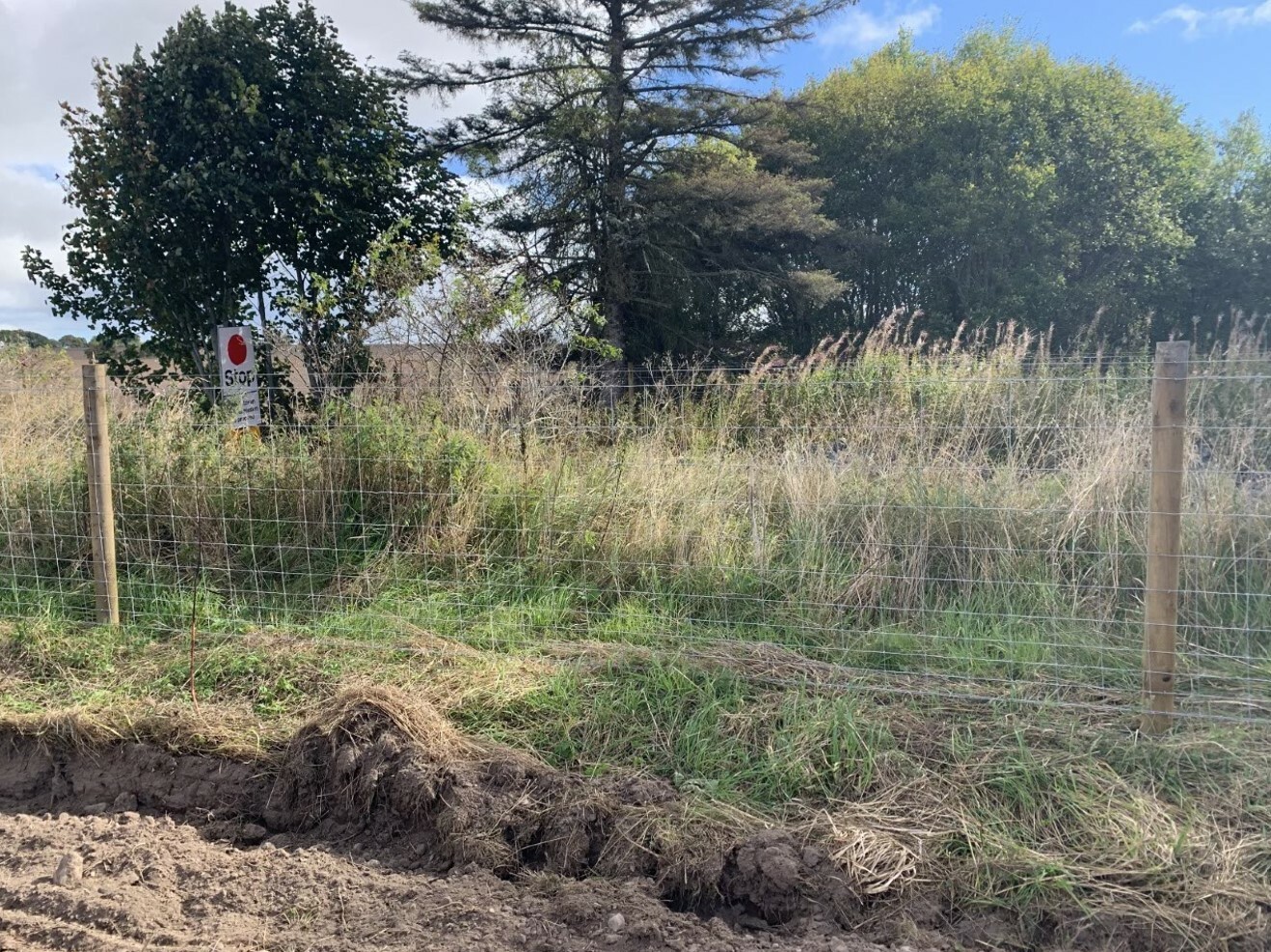
Stock Fence -
Seven-wire fence
This type of fence is 1.35m high and is typically installed in remote or inaccessible areas to mark our boundary.
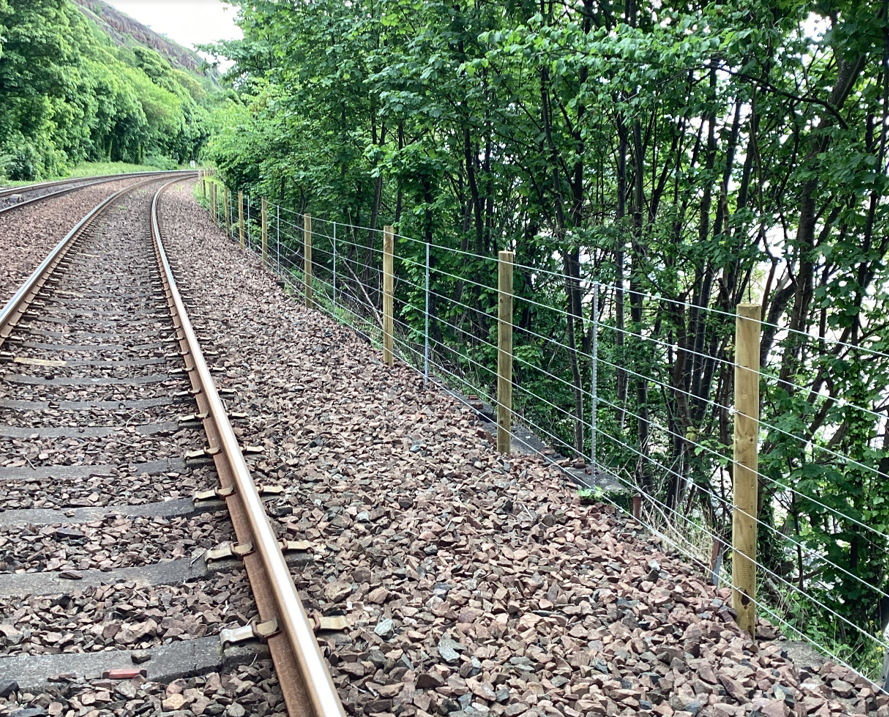
-
Boundary walls
In some cases the railway boundary is formed by a wall instead of a fence. Where appropriate to do so, we may repair or rebuild the existing wall instead of installing a fence - though this will not be possible in all cases. Where the wall cannot be repaired, we will either remove it and replace it with a fence, or install a new fence alongside the wall in order to provide a safe and secure boundary.
If you have any questions, please contact us:
Call: National Help Line on 03457 11 41 41
For more information visit here
